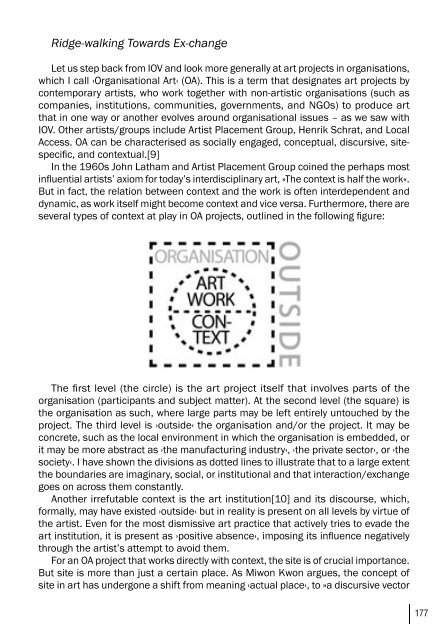art-e-conomy _ reader - marko stamenkovic
art-e-conomy _ reader - marko stamenkovic
art-e-conomy _ reader - marko stamenkovic
Create successful ePaper yourself
Turn your PDF publications into a flip-book with our unique Google optimized e-Paper software.
Ridge-walking Towards Ex-change<br />
Let us step back from IOV and look more generally at <strong>art</strong> projects in organisations,<br />
which I call ›Organisational Art‹ (OA). This is a term that designates <strong>art</strong> projects by<br />
contemporary <strong>art</strong>ists, who work together with non-<strong>art</strong>istic organisations (such as<br />
companies, institutions, communities, governments, and NGOs) to produce <strong>art</strong><br />
that in one way or another evolves around organisational issues – as we saw with<br />
IOV. Other <strong>art</strong>ists/groups include Artist Placement Group, Henrik Schrat, and Local<br />
Access. OA can be characterised as socially engaged, conceptual, discursive, sitespecific,<br />
and contextual.[9]<br />
In the 1960s John Latham and Artist Placement Group coined the perhaps most<br />
influential <strong>art</strong>ists’ axiom for today’s interdisciplinary <strong>art</strong>, »The context is half the work«.<br />
But in fact, the relation between context and the work is often interdependent and<br />
dynamic, as work itself might become context and vice versa. Furthermore, there are<br />
several types of context at play in OA projects, outlined in the following figure:<br />
The first level (the circle) is the <strong>art</strong> project itself that involves p<strong>art</strong>s of the<br />
organisation (p<strong>art</strong>icipants and subject matter). At the second level (the square) is<br />
the organisation as such, where large p<strong>art</strong>s may be left entirely untouched by the<br />
project. The third level is ›outside‹ the organisation and/or the project. It may be<br />
concrete, such as the local environment in which the organisation is embedded, or<br />
it may be more abstract as ›the manufacturing industry‹, ›the private sector‹, or ›the<br />
society‹. I have shown the divisions as dotted lines to illustrate that to a large extent<br />
the boundaries are imaginary, social, or institutional and that interaction/exchange<br />
goes on across them constantly.<br />
Another irrefutable context is the <strong>art</strong> institution[10] and its discourse, which,<br />
formally, may have existed ›outside‹ but in reality is present on all levels by virtue of<br />
the <strong>art</strong>ist. Even for the most dismissive <strong>art</strong> practice that actively tries to evade the<br />
<strong>art</strong> institution, it is present as ›positive absence‹, imposing its influence negatively<br />
through the <strong>art</strong>ist’s attempt to avoid them.<br />
For an OA project that works directly with context, the site is of crucial importance.<br />
But site is more than just a certain place. As Miwon Kwon argues, the concept of<br />
site in <strong>art</strong> has undergone a shift from meaning ›actual place‹, to »a discursive vector<br />
177


